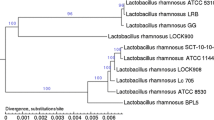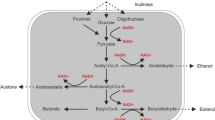Abstract
Recently, the industrial-scale development of microbial d-lactic acid production has been discussed. In this study, the efficiency of the new isolate Sporolactobacillus terrae SBT-1 for producing d-lactic acid under challenge conditions was investigated. The isolate SBT-1 exhibited superior activity in fermenting a very high glucose or sucrose concentration to d-lactic acid compared to the other S. terrae isolates previously reported in the literature; therefore, SBT-1 could overcome the limitations of effective lactic acid production. In batch cultivation using 360 g/L glucose, SBT-1 produced 290.30 g/L d-lactate with a sufficiently high glucose conversion yield of 86%, volumetric productivity of 3.02 g/L h, and optical purity of 96.80% enantiomer excess. SBT-1 could also effectively utilize 440 g/L sucrose as a sole carbon source to produce 276.50 g/L lactic acid with a conversion yield of 90%, a production rate of 2.88 g/L h, and an optical purity of 98%. d-Lactic acid fermentation by two other related producers, S. inulinus NRIC1133T and S. terrae NRIC0357T, was compared with fermentation by isolate SBT-1. The experimental data revealed that SBT-1 possessed the ability to ferment relatively high glucose or sucrose concentrations to d-lactic acid without obvious catabolite repression and byproduct formation compared to the two reference strains. In draft genome sequencing of S. terrae SBT-1, the results provided here can promote further study to overcome the current limitations for the industrial-scale production of d-lactic acid.






Similar content being viewed by others
References
Abdel-Rahman MA, Sonomoto K (2016) Opportunities to overcome the current limitations and challenges for efficient microbial production of optically pure lactic acid. J Biotechnol 236:176–192. https://doi.org/10.1016/j.jbiotec.2016.08.008
Amrane A, Prigent Y (1998) Lactic acid production rates during the different growth phases of Lactobacillus helveticus cultivated on whey supplemented with yeast extract. Biotechnol Lett 20(4):379–383
Beitel SM, Sass DC, Coelho LF, Contiero J (2016) High D(−) lactic acid levels production by Sporolactobacillus nakayamae and an efficient purification. Ann Microbiol 66(4):1367–1376. https://doi.org/10.1007/s13213-016-1224-4
Beitel SM, Coelho LF, Sass DC, Contiero J (2017) Environmentally friendly production of D(-) lactic acid by Sporolactobacillus nakayamae: Investigation of fermentation parameters and fed-batch strategies. Int J Microbiol. https://doi.org/10.1155/2017/4851612
Datta R, Henry M (2016) Lactic acid: recent advances in products, processes and technologies—a review. J Chem Technol Biotechnol 81(7):1119–1129. https://doi.org/10.1002/jctb.1486
Deutscher J (2008) The mechanisms of carbon catabolite repression in bacteria. Curr Opin Microbiol 11:87–93. https://doi.org/10.1016/j.mib.2008.02.007
Felsenstein J (1981) (1981) Evolutionary trees from DNA sequences: a maximum likelihood approach. J Mol Evol 1:368–376
Felsenstein J (1985) Confidence limits on phylogenies: an approach using the bootstrap. Evolution 39:783–791
Gran View Research (2019) Lactic acid market size, share & trend analysis report by raw material (corn, sugarcane), by application (industrial, food & beverages, polylactic acid), by region, and segment forecasts, 2019–2025. https://www.grandviewresearch.com/industry-analysis/lactic-acid-and-poly-lactic-acid-market. Accessed 18 Nov 2020
Gupta B, Revagade N, Hilborn J (2007) Poly(lactic acid) fiber: an overview. Prog Polym Sci 32(4):455–482. https://doi.org/10.1016/j.progpolymsci.2007.01.005
Han X, Huang K, Tang H, Ni J, Liu J, Xu P, Tao F (2019) Steps toward high-performance PLA: economical production of d-lactate enabled by a newly isolated Sporolactobacillus terrae strain. Biotechnol J 14(5):e1800656. https://doi.org/10.1002/biot.201800656
Huppert LA, Ramsdell TL, Chase MR, Sarracino DA, Fortune SM, Burton BM (2014) The ESX system in Bacillus subtilis mediates protein secretion. PLoS ONE 9:e96267. https://doi.org/10.1371/journal.pone.0096267
Jeckelmann J, Erni B (2020) Transporters of glucose and other carbohydrates in bacteria. Pflugers Arch Eur J Physiol 472:1129–1153. https://doi.org/10.1007/s00424-020-02379-0
Juturu V, Wu JC (2015) Microbial production of lactic acid: the latest development. Crit Rev Biotechnol 36(6):967–977. https://doi.org/10.3109/07388551.2015.1066305
Kanehisa M, Sato Y (2020) KEGG Mapper for inferring cellular functions from protein sequences. Protein Sci 29:28–35. https://doi.org/10.1002/pro.3711
Kim OS, Cho YJ, Lee K, Yoon SH, Kim M, Na H, Park SC, Jeon YS, Lee H, Yi H, Won S, Chun J (2012) Introducing EzTaxon-e: a prokaryotic 16S rRNA gene sequence database with phylotypes that represent uncultured species. Int J Syst Evol Microbiol 62:716–721
Kitahara K, Suzuki J (1963) Sporolactobacillus nov. subgen. J Gen Appl Microbiol 9:59–71
Klotz S, Kaufmann N, Kuenz A, Prusse U (2016) Biotechnological production of enantiomerically pure d-lactic acid. Appl Microbiol Biotechnol 100(22):9423–9437. https://doi.org/10.1007/s00253-016-7843-7
Overbeek R, Olson R, Pusch GD, Olsen GJ, Davis JJ, Disz T, Edwards RA, Gerdes S, Parrello B, Shukla M, Vonstein V, Wattam AR, Xia F, Stevens R (2014) The SEED and the rapid annotation of microbial genomes using subsystems technology (RAST). Nucleic Acids Res 42(D1):D206–D214. https://doi.org/10.1093/nar/gkt1226
Papadimitriou K, Alegria A, Bron PA, de Angelis M, Gobbetti M, Kleerebezem M, Lemos JA, Linares DM, Ross P, Stanton C, Turroni F, van Sinderen D, Varmanen P, Ventura M, Zúñiga T, Kok J (2016) Stress physiology of lactic acid bacteria. Microbiol Mol Biol Rev 80(3):837–890. https://doi.org/10.1128/MMBR.00076-15
Prasirtsak B, Thitiprasert S, Tolieng V, Assabumrungrat S, Tanasupawat S, Thongchul N (2017) Characterization of d-lactic acid, spore-forming bacteria and Terrilactibacillus laevilacticus SK5-6 as potential industrial strains. Ann Microbiol 67(11):763–778. https://doi.org/10.1007/s13213-017-1306-y
Reed MC, Lieb A, Nijhout HF (2010) The biological significance of substrate inhibition: a mechanism with diverse functions. Bioassays 32:422–429. https://doi.org/10.1002/bies.200900167
Reid SJ, Abratt VR (2005) Sucrose utilisation in bacteria: genetic organisation and regulation. Appl Microbiol Biotechnol 67(3):312–321. https://doi.org/10.1007/s00253-004-1885-y
Richter M, Rosselló-Móra R, Glöckner FO, Peplies J (2016) JSpeciesWS: a web server for prokaryotic species circumscription based on pairwise genome comparison. Bioinformatics (oxford, England) 32:929–931
Saitou N, Nei M (1987) The neighbor-joining method: a new method for reconstructing phylogenetic trees. Mol Biol Evol 4:406–425
Syrokou MK, Paramithiotis S, Drosinos EH (2019) Lactic acid bacteria responses to osmotic challenges. In: Leblanc JG, De Leblanc ADM (eds) The many benefits of lactic acid bacteria. Nova Science Publishers, New York, pp 75–87
Tamura K, Stecher G, Peterson D, Filipski A, Kumar S (2013) MEGA6: molecular evolutionary genetics analysis version 6.0. Mol Biol Evol 30:2725–2729
Tanasupawat S, Ezaki T, Suzuki KI, Okada S, Komagata K, Kozaki M (1992) Characterization and identification of Lactobacillus pentosus and Lactobacillus plantarum strains from fermented foods in Thailand. J Gen Appl Microbiol 38:121–134
Tanasupawat S, Okada S, Komagata K (1998) Lactic acid bacteria found in fermented fish in Thailand. J Gen Appl Microbiol 4:193–200
Thamacharoensuk T, Tolieng V, Thongchul N, Kodama K, Tanasupawat S (2016) Characterisation of lactic acid producing Sporolactobacillus strains from tree barks in Thailand. Ann Microbiol 67(2):215–218. https://doi.org/10.1007/s13213-016-1248-9
Thitiprasert S, Thongchul N, Tanasupawat S (2019) Spore-forming lactic acid bacteria and their abilities for utilization. In: Leblanc JG, De Leblanc ADM (eds) The many benefits of lactic acid bacteria. Nova Science Publishers, New York, pp 293–317
Tonkin-Hill G, MacAlasdair N, Ruis C, Weimann A, Horesh G, Lees JA, Gladstone RA, Lo S, Beaudoin C, Floto RA, Frost SDW, Corander J, Bentley SD, Parkhill J (2020) Producing polished prokaryotic pangenomes with the Panaroo pipeline. Genome Biol 21(1):180. https://doi.org/10.1186/s13059-020-02090-4
Warr SRC, Gershater CJL, Box SJ (1996) Seed stage development for improved fermentation performance: increased milbemycin production by Streptomyces hygroscopicus. J Ind Microbiol 16:295–300
Wattam AR, Davis JJ, Assaf R, Boisvert S, Brettin T, Bun C, Conrad N, Dietrich EM, Disz T, Gabbard JL, Gerdes S, Henry CS, Kenyon RW, Machi D, Mao C, Nordberg EK, Olsen GJ, Murphy-Olson DE, Olson R, Overbeek R, Parrello B, Pusch GD, Shukla M, Vonstein V, Warren A, Xia F, Yoo H, Stevens RL (2017) Improvements to PATRIC, the all-bacterial Bioinformatics Database and Analysis Resource Center. Nucleic Acids Res 45(D1):D535–D542. https://doi.org/10.1093/nar/gkw1017
Wee YG, Jin-Nam Kim JN, Ryu HW (2006) Biotechnological production of lactic acid and its recent applications. Food Technol Biotechnol 44(2):163–172
Yanagida F, Suzuki K-I, Kozaki M, Komagata K (1997) Proposal of Sporolactobacillus nakayamae subsp. nakayamae sp. nov., subsp. nov., Sporolactobacillus nakayamae subsp. racemicus subsp. nov., Sporolactobacillus terrae sp. nov., Sporolactobacillus kofuensis sp. nov., and Sporolactobacillus lactosus sp. nov. Int J Syst Evol Microbiol 47(2):499–504
Zhao T, Liu D, Ren H, Shi X, Zhao N, Chen Y, Ying H (2014) d-Lactic acid production by Sporolactobacillus inulinus Y2–8 immobilized in fibrous bed bioreactor using corn flour hydrolyzate. J Microbiol Biotechnol 24:1664–1672
Zheng L, Liu M, Sun J, Wu B, He B (2017) Sodium ions activated phosphofructokinase leading to enhanced d-lactic acid production by Sporolactobacillus inulinus using sodium hydroxide as a neutralizing agent. Appl Microbiol Biotechnol 101(9):3677–3687. https://doi.org/10.1007/s00253-017-8120-0
Acknowledgements
We thank the Department of Molecular Microbiology, Faculty of Life Science, and NODAI Genome Research Center at Tokyo University of Agriculture (Japan) for supporting and facilitating the whole-genome sequence analysis.
Funding
This study was supported by the Biorefinery Cluster, Chulalongkorn University, Research Chair Grant provided by the National Science and Technology Development Agency (NSTDA), and Thailand Research Fund under Grant No. RTA6280014. Dr. Thitiprasert was the recipient of the Chulalongkorn University Office of International Affairs Scholarship Program for Short-term Research (Thailand).
Author information
Authors and Affiliations
Corresponding author
Ethics declarations
Conflict of interest
The authors declare no conflicts of interest.
Additional information
Communicated by Erko Stackebrandt.
Publisher's Note
Springer Nature remains neutral with regard to jurisdictional claims in published maps and institutional affiliations.
Supplementary Information
Below is the link to the electronic supplementary material.
Rights and permissions
About this article
Cite this article
Thitiprasert, S., Piluk, J., Tolieng, V. et al. Draft genome sequencing of Sporolactobacillus terrae SBT-1, an efficient bacterium to ferment concentrated sugar to d-lactic acid. Arch Microbiol 203, 3577–3590 (2021). https://doi.org/10.1007/s00203-021-02352-0
Received:
Revised:
Accepted:
Published:
Issue Date:
DOI: https://doi.org/10.1007/s00203-021-02352-0




